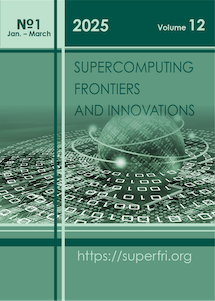Recent Technology Trends in High-Performance Computing: Quantifying the Divergence of Top and the Rest
DOI:
https://doi.org/10.14529/jsfi250101Keywords:
TOP500_List, energy efficiency, supercomputer technology trends, Zipf’s lawAbstract
Exploratory analysis methods were used to study basic characteristics of computing systems from TOP500_Lists. One of the peculiarities of the distribution of computing systems by performance is that it sufficiently well obeys an analog of the empirical Zipf’s law, in which logarithm of performance is reciprocal to the rank of computing system. Based on this observation we can divide all systems from the lists into several performance classes: top, high, base, and entry levels. Our analysis also revealed differences between these classes in other characteristics besides, the computational performance, e. g., such as power consumption. For all performance classes, trends in evolution of the basic characteristics of TOP500 computing systems were described and, where possible, comments were provided to explain their behavior. Performance and energy efficiency of the TOP500_List computing systems in the next 5–10 years were estimated using simple linear models obtained by the least-square method. We have found that energy consumption needed for entry-level supercomputers to surpass the threshold value of performance and to enter into TOP500_List will decrease during this period.
References
Abramov, N.S., Abramov, S.M.: Top500 list overview. Supercomputing Frontiers and Innovations 10(2), 4–17 (2023). https://doi.org/10.14529/jsfi230201
Austin, B., Daley, C.S., Doerfler, D., et al.: A metric for evaluating supercomputer performance in the era of extreme heterogeneity. In: 2018 IEEE/ACM Performance Modeling, Benchmarking and Simulation of High Performance Computer Systems, PMBS@SC 2018, Dallas, TX, USA, November 12, 2018. pp. 63–71. IEEE (2018). https://doi.org/10.1109/PMBS.2018.8641549
Davis, N.E., Robey, R.W., Ferenbaugh, C.R., et al.: Paradigmatic shifts for exascale supercomputing. J. Supercomput. 62(2), 1023–1044 (2012). https://doi.org/10.1007/S11227-012-0789-3
Khan, A., Sim, H., Vazhkudai, S.S., et al.: An analysis of system balance and architectural trends based on Top500 supercomputers. In: Hwang, S., Yeom, H.Y. (eds.) HPC Asia 2021: The International Conference on High Performance Computing in Asia-Pacific Region, Virtual Event, Republic of Korea, January 20–21, 2021. pp. 11–22. ACM (2021). https://doi.org/10.1145/3432261.3432263
Kogge, P., Borkar, S., Campbell, D., et al.: Exascale computing study: Technology challenges in achieving exascale systems. Defense Advanced Research Projects Agency Information Processing Techniques Office (DARPA IPTO), Techinal Representative 15 (01 2008)
Kogge, P.M., Dally, W.J.: Frontier vs the exascale report: Why so long? and are we really there yet? In: IEEE/ACM International Workshop on Performance Modeling, Benchmarking and Simulation of High Performance Computer Systems, PMBS@SC 2022, Dallas, TX, USA, November 13–18, 2022. pp. 26–35. IEEE (2022). https://doi.org/10.1109/PMBS56514.2022.00008
Kogge, P.M., Dysart, T.J.: Using the TOP500 to trace and project technology and architecture trends. In: Lathrop, S.A., Costa, J., Kramer, W. (eds.) Conference on High Performance Computing Networking, Storage and Analysis, SC 2011, Seattle, WA, USA, November 12–18, 2011. pp. 28:1–28:11. ACM (2011). https://doi.org/10.1145/2063384.2063421
Meuer, H.W.: The TOP500 project: Looking back over 15 years of supercomputing experience. Inform. Spektrum 31(3), 203–222 (2008). https://doi.org/10.1007/S00287-008-0240-6
Downloads
Published
How to Cite
Issue
License
Authors retain copyright and grant the journal right of first publication with the work simultaneously licensed under a Creative Commons Attribution-Non Commercial 3.0 License that allows others to share the work with an acknowledgement of the work's authorship and initial publication in this journal.

